Back on the Northern Line (Again!) - at the north of Lake Como
So, with the weather improved , I am back on the -Northern Line again. No not the Edgware Line , but Italy’s Northern Frontier line, known as the Linea Cadorna or to give its proper name Sistema Difensivo Italiano alla Frontiera Nord con la Svizzera. Italy’s Maginot Line, although never tested. We start with an appropriate quote from C P Cavafy’s 1904 poem., “ Waiting for the Barbarians”, which sort of sums it up.
“Because night has fallen and the barbarians haven't come.
And some of our men just in from the border say
there are no barbarians any longer.”
This is one of the easier parts of the Linea Cadorna to visit by public transportation, easily accessible From the railway station at Dorio. Dorio is on the Lecco to Colico line . Well I would qualify that by saying getting to the entrance for the path to the fortifications is extremely straightforward, getting up to the fortifications less so. In fact I would warn not to try and do so unless you are fully mobile and wearing hiking boots. I would also suggest its is not well adapted for taking children or dogs up there, especially since there are wild animals up in the woods. Fortunately this time , did not have any Wild Boar encounters although they are probably up there somewhere, just a couple of harmless chamois who were obviously better adapted to the conditions then me, Anyway we have got slightly ahead of ourselves.
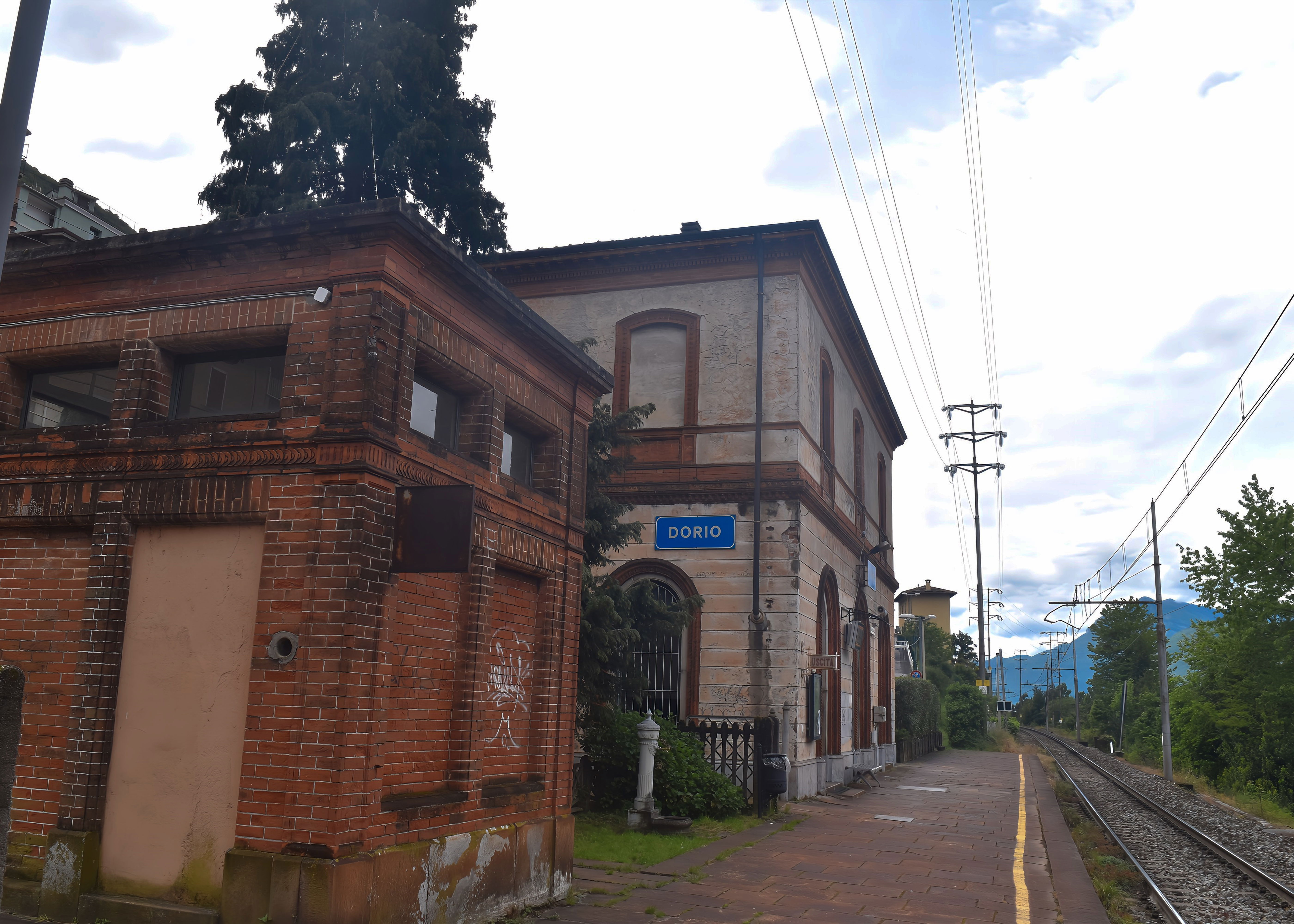
Dorio Railway Station
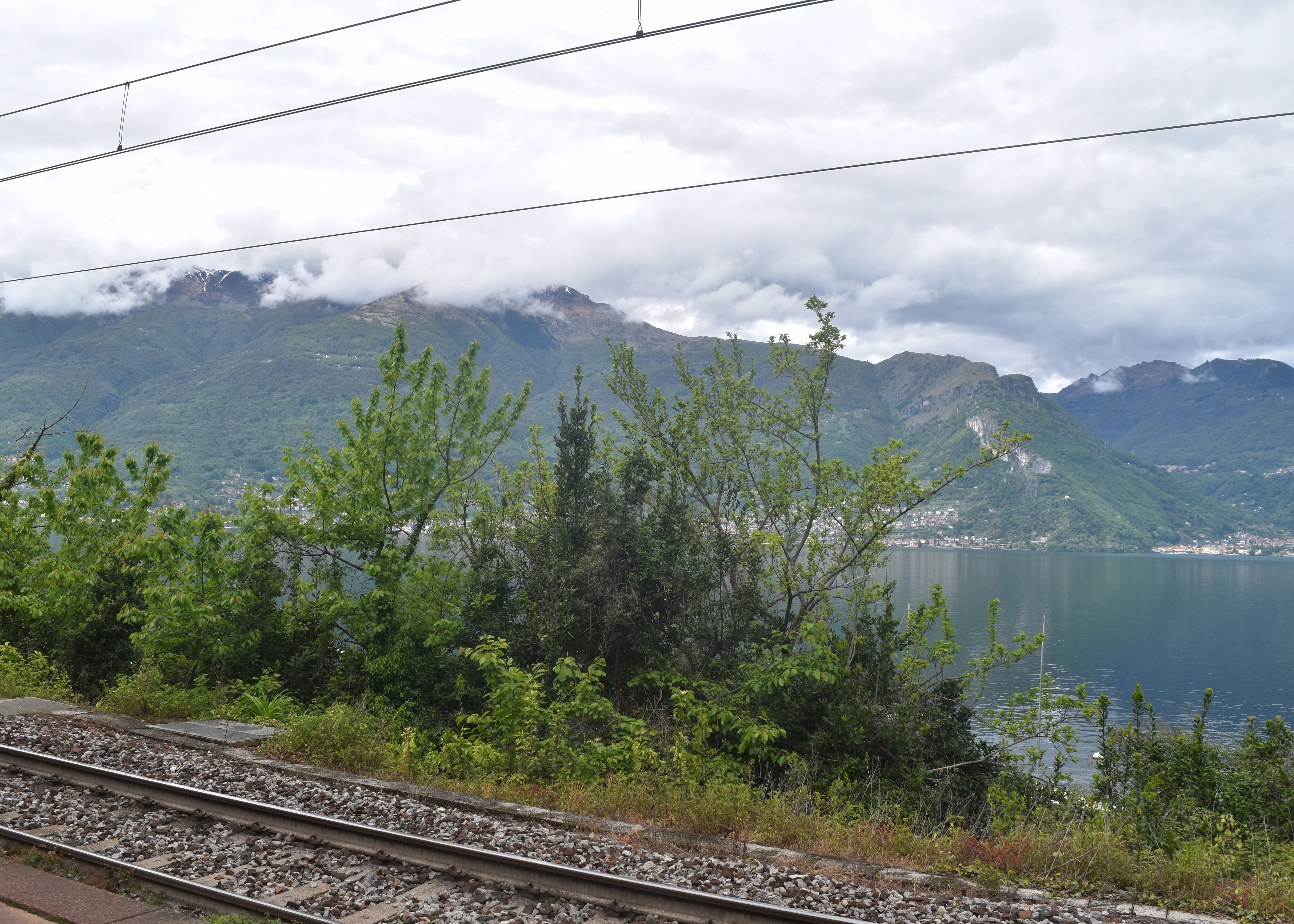
The railway line to Colico
To get to Dorio from Milan, you need to take the Sondrio line from Milan Central. This evolved in various stages. First the Milan to Monza route, which is the second oldest railway in Italy dating from the 1840s. The line was extended from Monza to Lecco in the 1860’s and then in the 1870s along the eastern shore of Lake Como , as far as Colico. For Dorio, it is often necessary to change at Bellano TT , probably involving a wait of around twenty minutes. If you travel from Milan , you may find it better to avoid the weekends. I was somewhat surprised to find the train already full at Monza, which is highly unusual for Saturday, Apparently this is due to the Varenna phenomenon, Varenna is a small and very picturesque village halfway up the lake is now besieged by tourists. Whether it is due to successful marketing or the Instagram opportunities , at this small village of 700 people sees hourly trains from Milan disgorging several hundred tourists every hour. The train was as full as the Northern Line at peak time , with standing room only , I thought there was a festival going on, but a local man told me that it was the new normal every weekend. So if you want to see Varenna , probably best to avoid the weekends, especially around public holidays. Anyway all the crowds got off at Varenna and I finally got a seat and nobody’s elbow in my face. If you have to change at Bellano , it is an attractive station to chill for twenty minutes whole waiting the connection. when the train arrives, it is only two stops or about 6 minutes to Dorio.
At Dorio, you have to exit the station and walk right to the far edge of the car park, where there are some steps down to the underpass which takes you under the railway and out to the lakeside ( it is signposted to Corenno Plinio) . At the lakeside there is a gentle path, which passes some small beaches, mainly full of boats and some splendid views across and up the lake.

The underpass to the lake side

Lake Como looking towards Colico
Take the opportunity to look up the north towards the ends of the Lake towards Colico, for some spectacular views. At the beginning of May, there is still snow up on the peaks towards Monte Spluga. There is a fine view across to the western shore, with a wall of mountains above the lake and Switzerland on the other side. Continuing along the lake shore, you have to take an underpass under the railway and then about 50 metres further on, take a small tunnel back to the lakeside again ( it is marked with a banner for Fuoridivela) . back on the lakeside you pass by Fuoridivela which seems to be a small yachting school and then the path takes you up to Corenno Plinio.
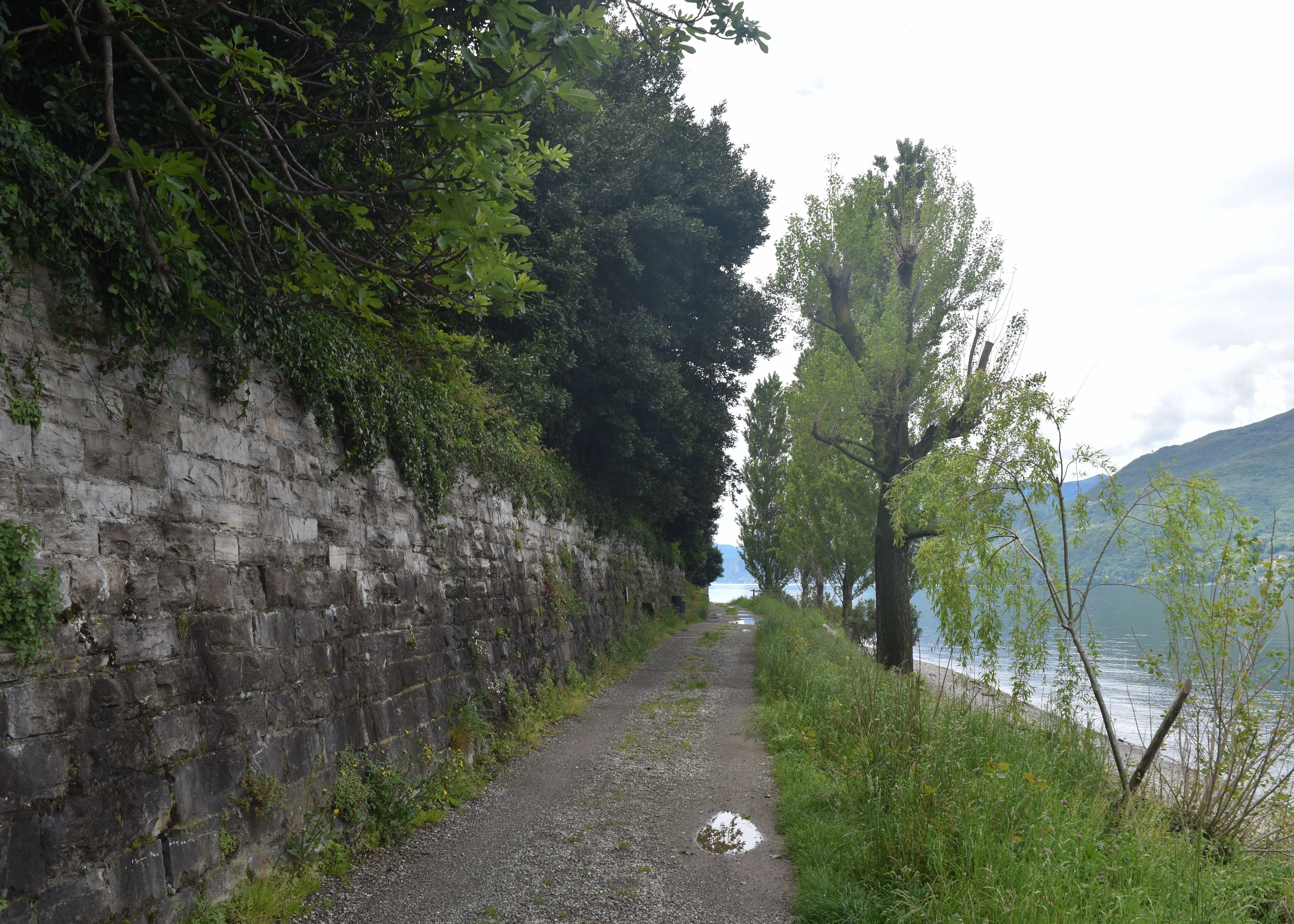
Sentiero del Viandante a.long the lake shore

Another railway underpass
The footpath along the Lake is called the Sentiero del Viandante, which literally means the path for walkers. Before the construction of the road and railway , there were only two ways to get from Lecco up to Colico , either by boat or on foot. The boat was best suited for moving bulk, the footpaths for travellers, pilgrims and small merchants hawking from village to village up the lake. The road only ran from Milan to Bellagio, where travellers had to get a boat across the Lake to the Via Regina, the former Roman road on the other side. The Spanish occupiers toyed with the idea of a road along the eastern shore, mainly to get to their border Fort, Fort Fuentes.- but they sort of said manana and did not bother. The Austrian occupiers decided to expand the road network, extending the military road which ran from Milan to the Palazzo Reale at Monza. They then extended to Lecco and decided for mainly military reasons to connect Lecco with Calico and then up to the Monte Spluga pass beyond Chiavenna. In 1824 they started the strada militare lacuale, which involved eight tunnels on the way. The road was executed by an Italian engineer Carlo Donegani and finished in 1832, (it is now mainly the (ss36) At the top end of the Lake bit connected with the Austrian road to the Stelvio pass and into Austria. .So after the road and the railway was built,, there was not so much use for the old lakeside paths- which now form part of a long distance footpath from Milan to Monte Spluga. This slight digression into road building becomes significant in looking at the fortifications.
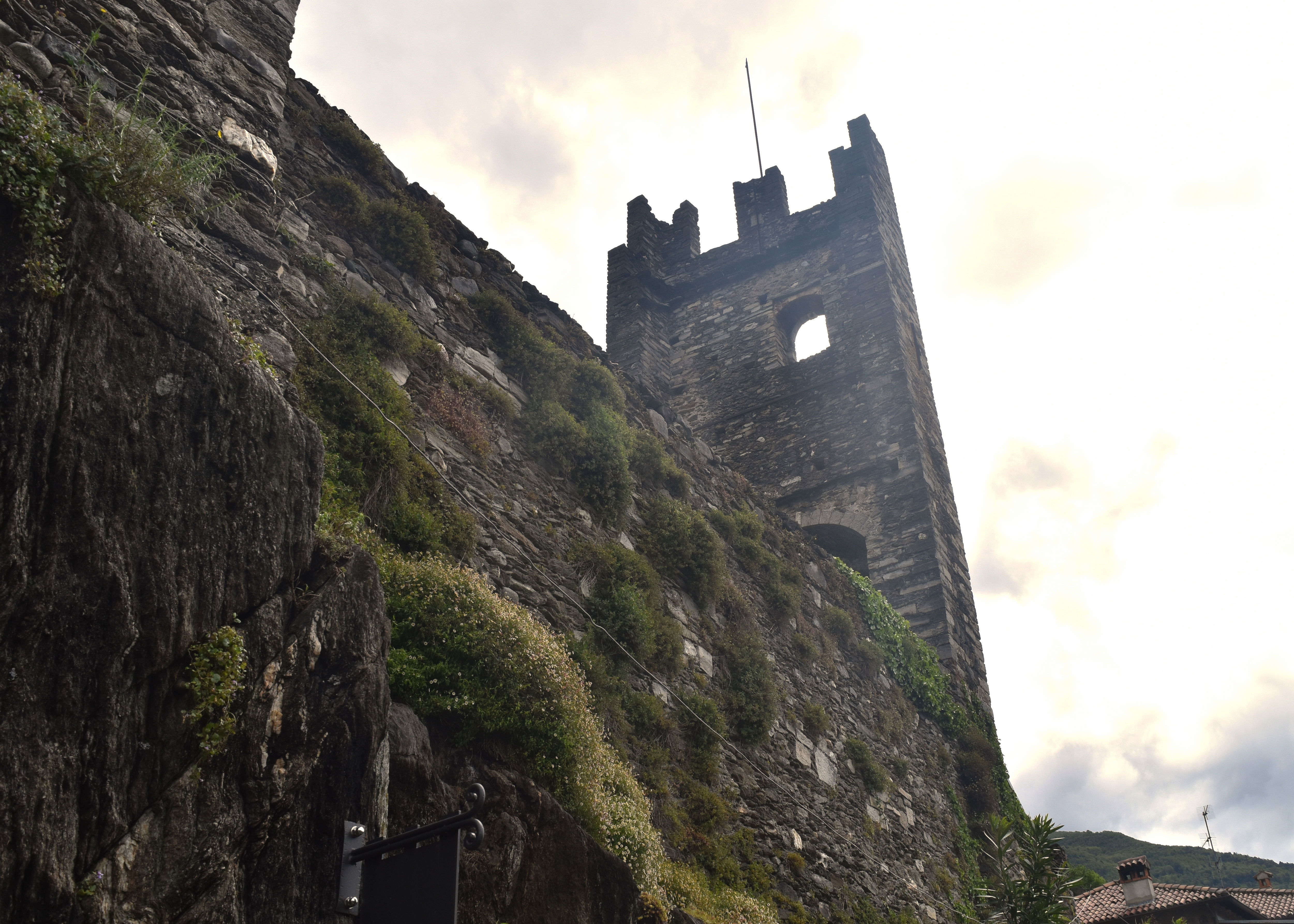
The Castle at Corenno
Emerging in Corenno Plinio, the Andreani Castle, built on a cliff, is one of the best examples of fortification on Lake Como. Although victim of various sieges and assaults throughout the centuries, it is well preserved. Corenno, thanks to its strategic position own the lake has always been a fortified village, dating back to the Bronze Age . The current fortress was finished in around 1357, but its origins date back to the gift in 1271 of the feud to Fossato Andreani by the archbishop of Milan, Ottone Visconti. The castle has a curtain wall in an irregular plan constructed entirely in stone, which provided refuge for the local inhabitants. There are two towers: a thin one at the entrance to guard southwards and a strongly-built quadrangular one on the north side. Part of the wall on the lakeside was demolished in recent times to enjoy the landscape and to grow a vineyard. The castle is private property, although apparently guided tours can be booked.
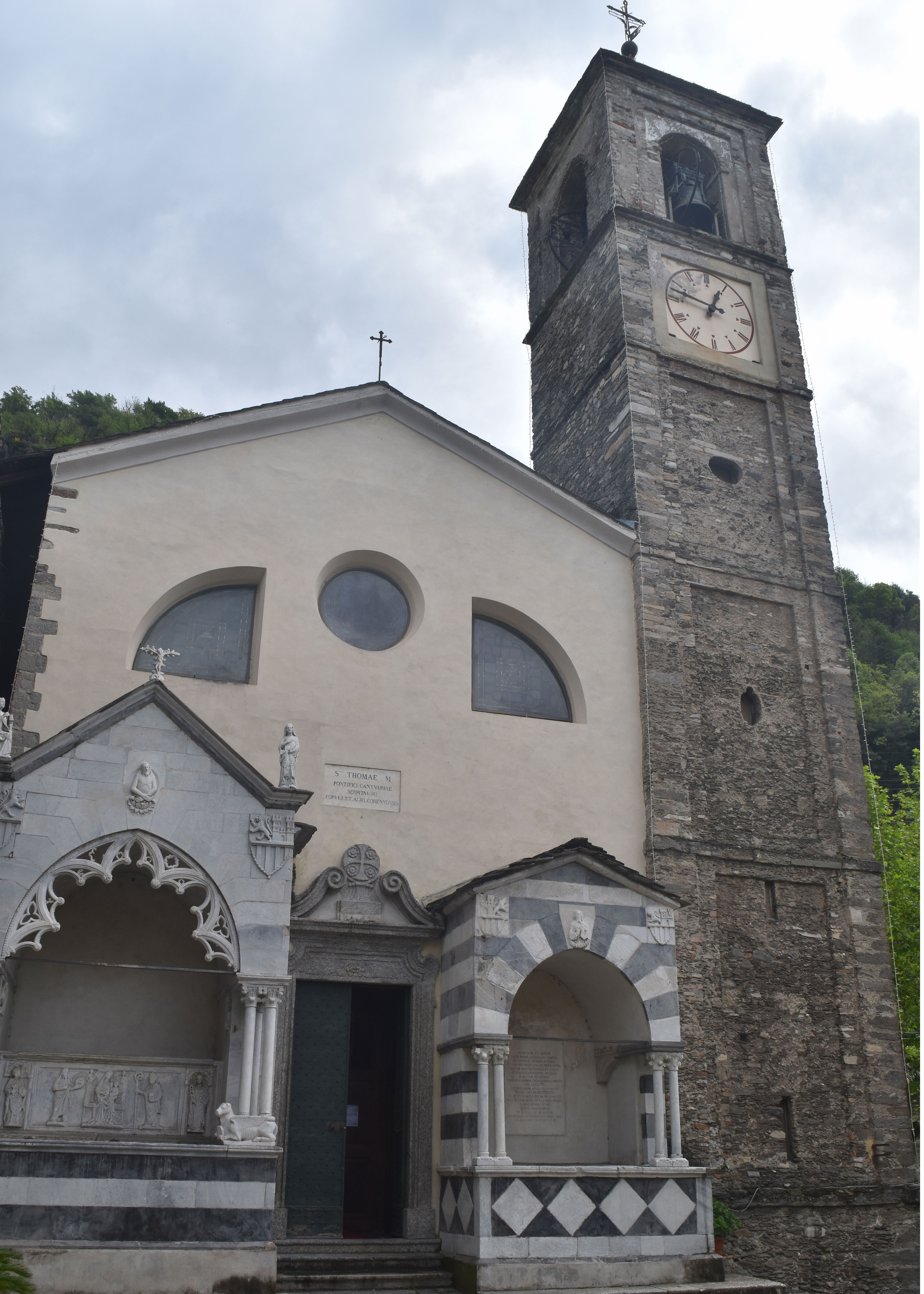
The Church of St. Thomas of Canterbury
The Andreani family also built the next door church which commemorate St. Thomas of Canterbury, or Thomas a Becket. Unusual to find a church commemorating an English saint at the top end of Lake Como. Apparently there are numerous churches dedicated to St. Thomas all over Italy and he and his relics became quite popular there. Possibly something to do with the church sending a message to over mighty secular lords or something. The church was built in the 1370s , about two hundred yeas after Thomas’s murder in Canterbury Cathedral , many Italians made the pilgrimage to Canterbury and some of St. Thomas’s relics might have ended up in Italy, so maybe that was the attraction to the Andreani family.
It is a very lovely little church with some fourteenth century frescoes, which although much damaged are still well preserved. In the Adoration of the magi , only two remain . The Virgin Mary is surrounded by St Roch whose legs are missing, so we cannot see his characteristic plague buboes and St. Sebastian with rather fewer arrows than normal. Joking aside, these parts of Italy were devastated by wave after wave after plague , bearing in mind the church was bult after the Black Death, the presence of St Roch and St Sebastian who traditionally interceded against plague is not unusual. St Sebastian also had strong connections with Milan and Lombardy. Another fresco includes St Apollonia, portrayed as usual undergoing some rather painful dental work and St Gotthard. This is the first time. I have seen a portrayal of St Gotthard, who gave his name to the pass in Switzerland ( and now to the Gotthard Bsse Tunnel), so maybe we should expand a bit.
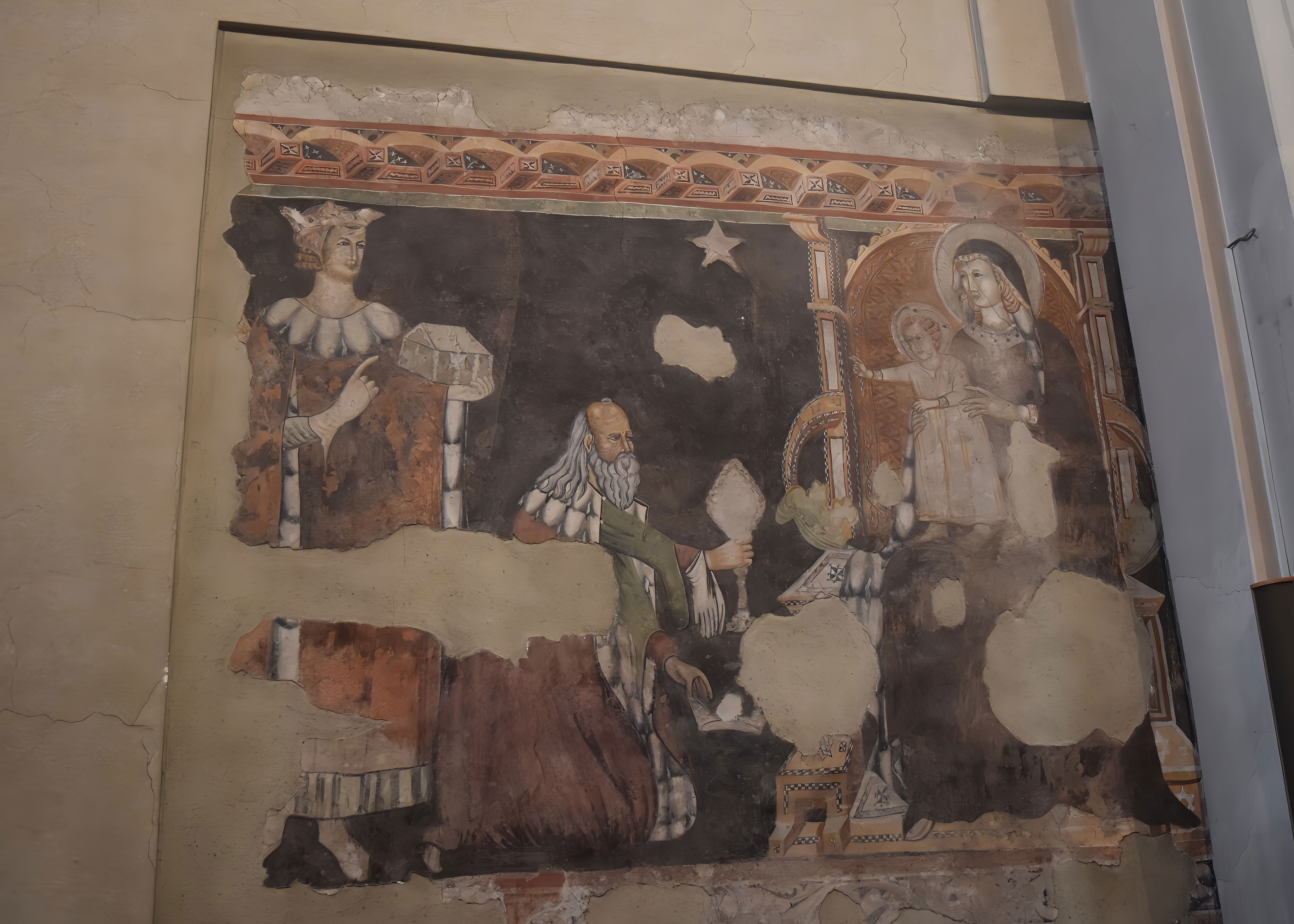
Adoration of the Magi ( well two of them )
Having taken in the church, there is a very handy little information booth, which also collects parking fees. I asked for directions and a helpful young chap directed me across the main road and to the left , where there is indeed a sign to the trenches. It says trenches 20 minutes. It lies, well maybe 20 minutes to the first trench, if you are used to running Iron Man marathons or something. If you ae an aging, relatively unfit individual double that and more. The entranced is typical of other entries to the Linea Cadorna, up by the side of a house and into the woods.
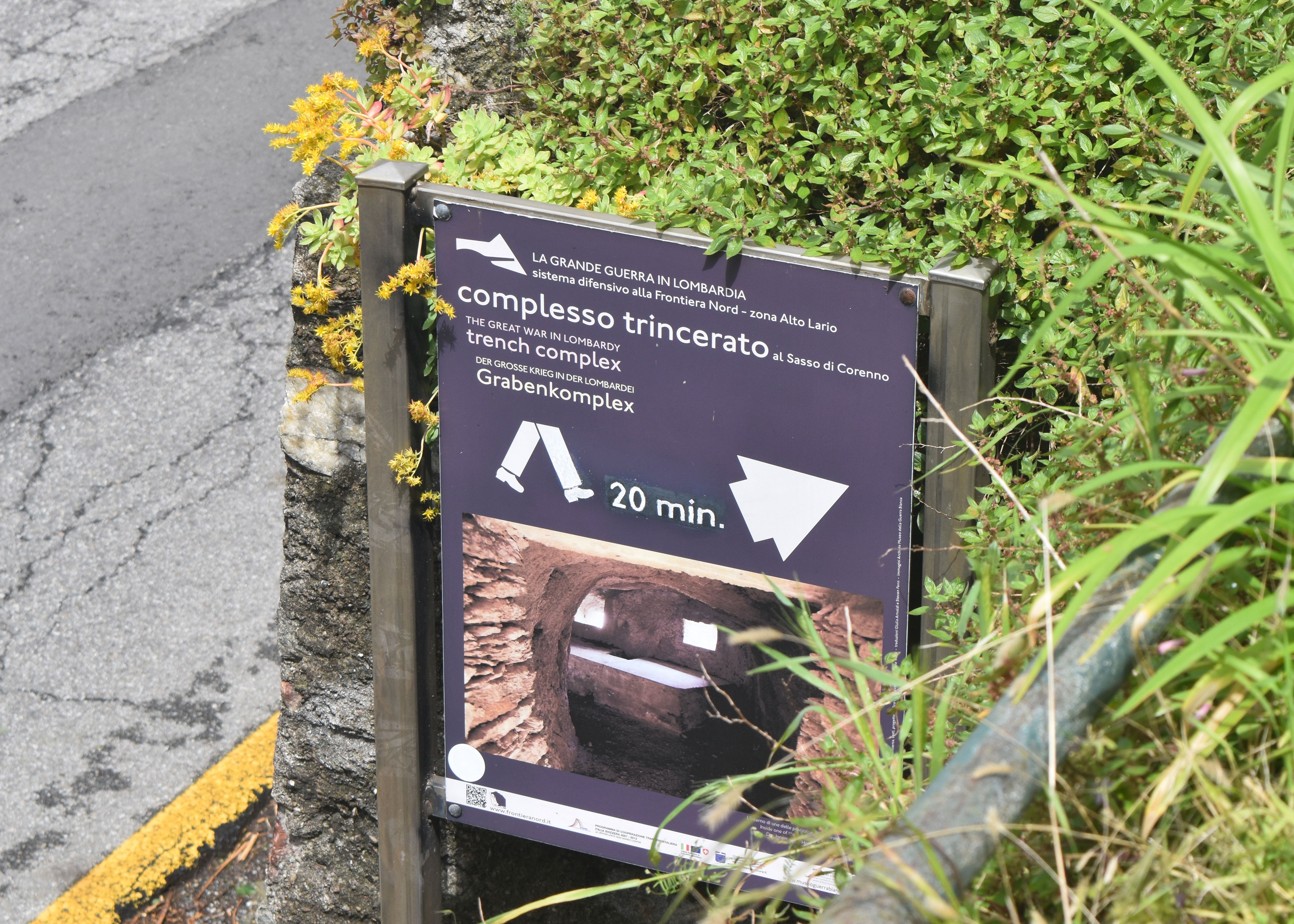
The footpath up to the Linea Cadorna
A warning , if you are less than sure footed do not go up there. There is a well defined path and doubtless it is lovingly maintained by the local Alpini, but it is tough going. Apart from being steep, there is a military mule track , but its lose in a lot of places and in Spring there is a lot of lose leaves around, The situation not helped by the last month of continuous rain in Lombardy. If you go up there, please use suitable footwear – also there are a lot of brambles and nettles around so shorts are short sleeves may not be recommended. Also, there is no water up there, so take some- even in a relatively cool Spring it is tough going. I mentioned the boars, I did not see any this time– but they are out there somewhere they ae everywhere in Italy – so keep any eye out and do not take small aggressive dogs ( sorry Spritz!) up there. So far , fairly common sense stuff for visiting the Linea Cadorna,.

In the end , you reach the first machine gun emplacement, almost hidden by the vegetation. Dug into the rock there are two loopholes, one facing the village of Corenno and the other on the road coming from Colico. By its location, this was presumably intended to defend the rest of the site, if anybody tried attacking up the hill.
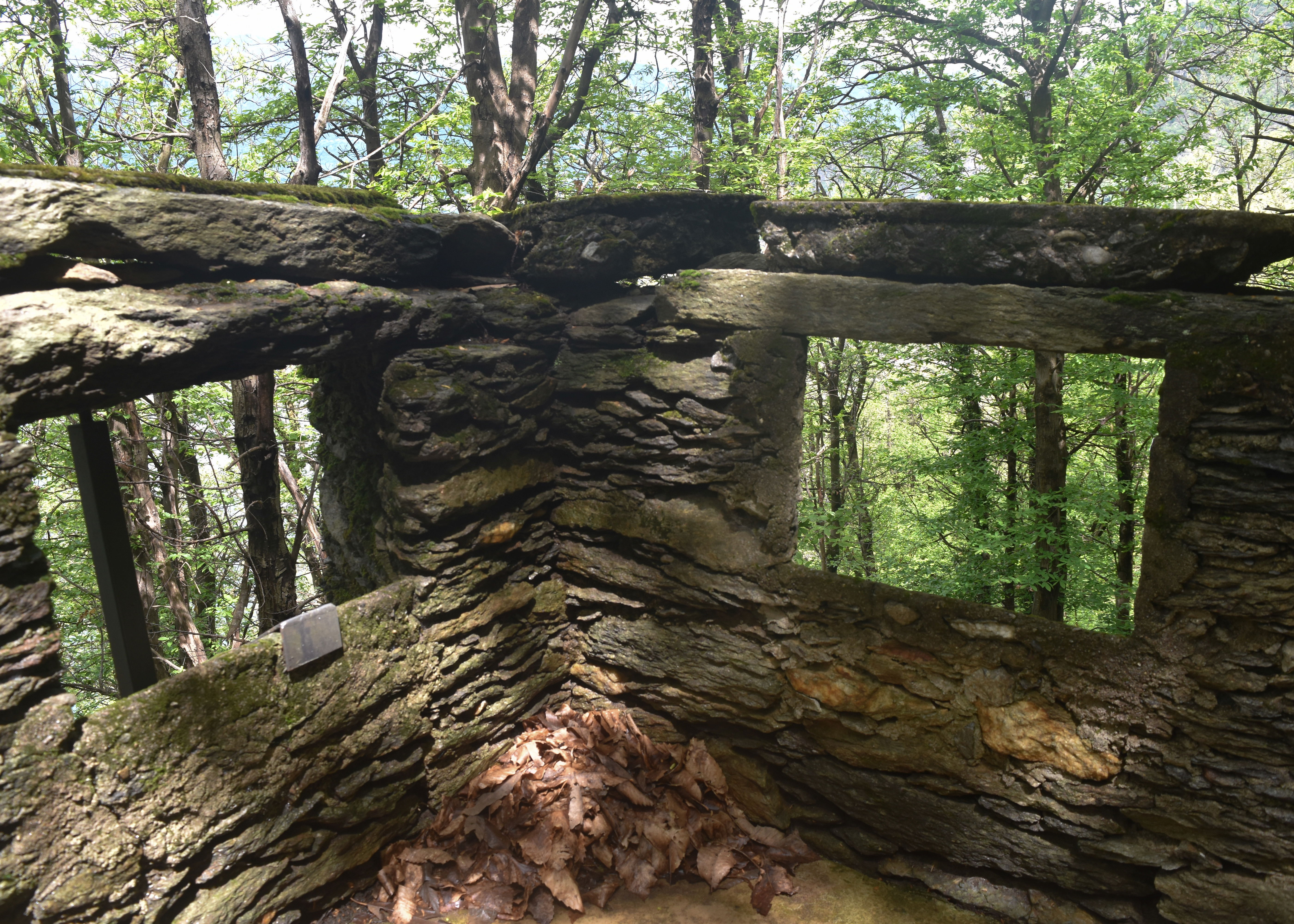
Machine gun position guarding the path up
A little further on there is a fork in the road with signposts for the trenches and the armoured position for the riflemen. It is actually well sign posted , although it says 15 minutes and again it is more. Continuing on the “steep but not too demanding path with steps” ( that was from a guide book and I beg to differ ) , you arrive at the main trenches, They are at a panoramic point overlooking the lake with the peninsula of Olgiasca below. The fortifications are typical of the Linea Cadorna, roughhewn into the rock, built with local stone and not so much cement up here, with loopholes for firing and compartments for keeping ammunition, food and cigarettes dry. As a defensive position, the defenders are dominating any attackers advancing on the road and railway below. Rather than defend undefendable positions nearer to the frontier the Italians were using the local topography and natural defensive positions to defend deeper in their own territory. Although the big guns at Fort Montecchio are only a few kilometres to the north, it seemed accepted that these were vulnerable and might quickly be lost to an invasion, so with the imperative of defending the road and preventing an invading army getting to the Lombard plain, they chose to defend here.
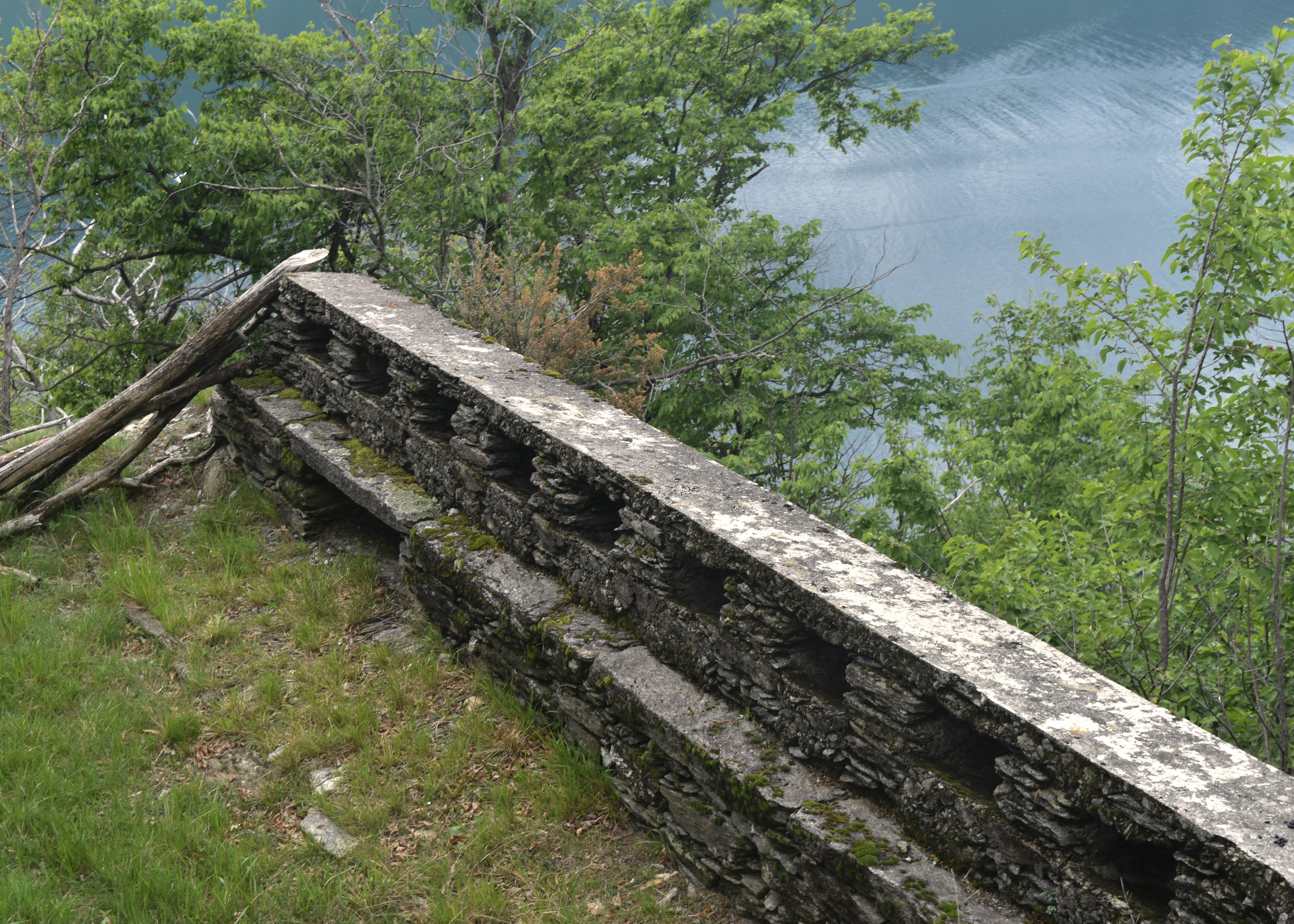
A firing position overlooking the lake
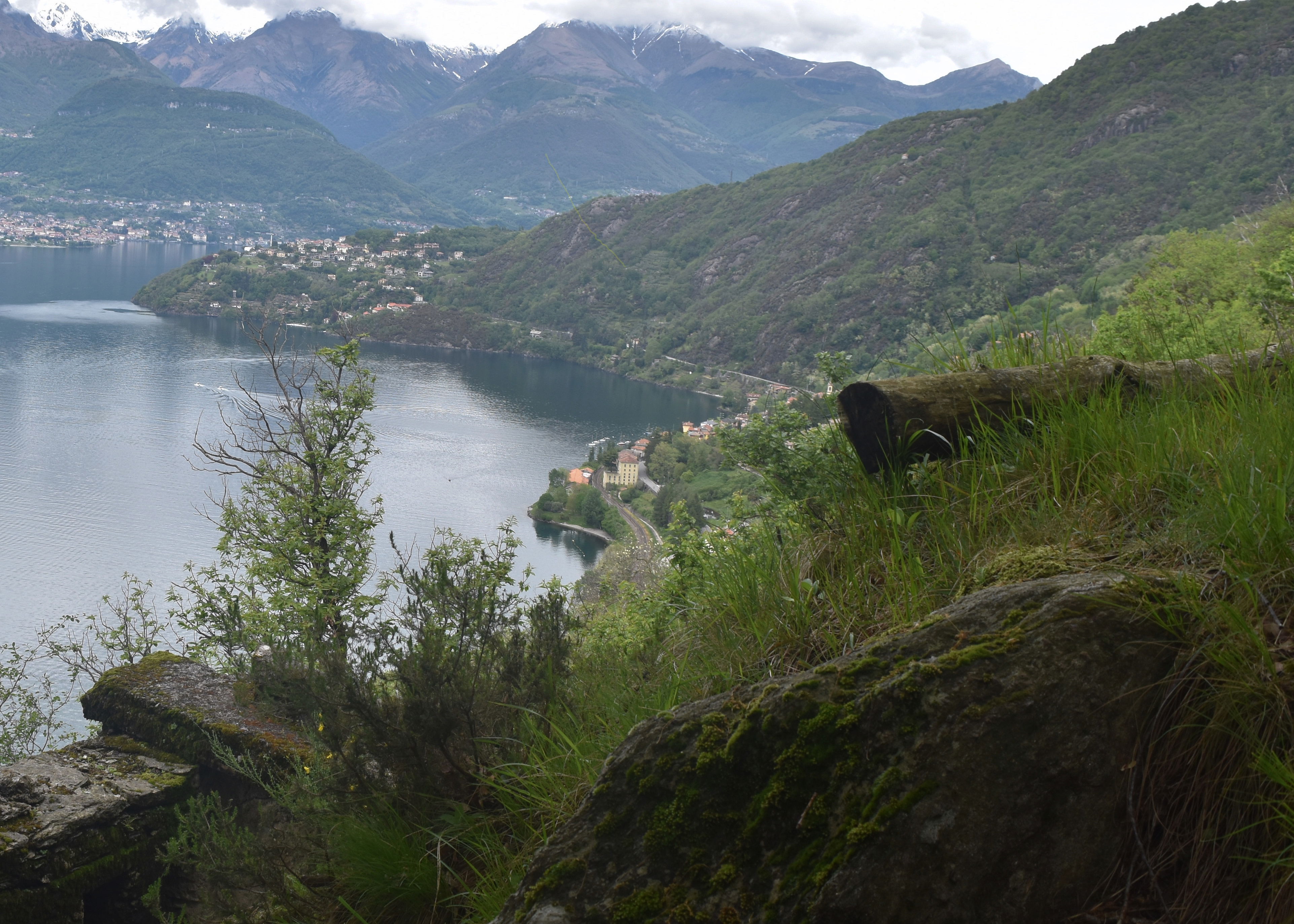
Firing positions overlooking the road up the lake side to Monte Spluga and Switzerland
The standard Italian Machine Gun in the First World war was the Mitragliatrice Modello 14, which apparently had a maximum range of about 3000 metres, could probably hit the enemy on the road below, even if somewhat less effectively. The modello 14, could fire around 250 rounds per minute up to a maximum of 500. On the downside it needed a crew of five and was water-cooled. After a heavy rain, kit s quite wet up there, but not sure how useful rainwater is for cooling machine-guns. The whole thing also weighed 43,4 kg which must have been pretty difficult to get up there. Accounts suggested it was not very reliable and needed a lot of oil to fire properly. On the positive side, it took the same 6.5 mm ammunition issued to the infantry for the Carcano M1891 rifle, so they did not need to bring up double loads of ammunition. Not being any military expert, I am admiring the view over the lake, but clearly with the advantage of height and concealment, it strikes as being a fairly useful defensive position.
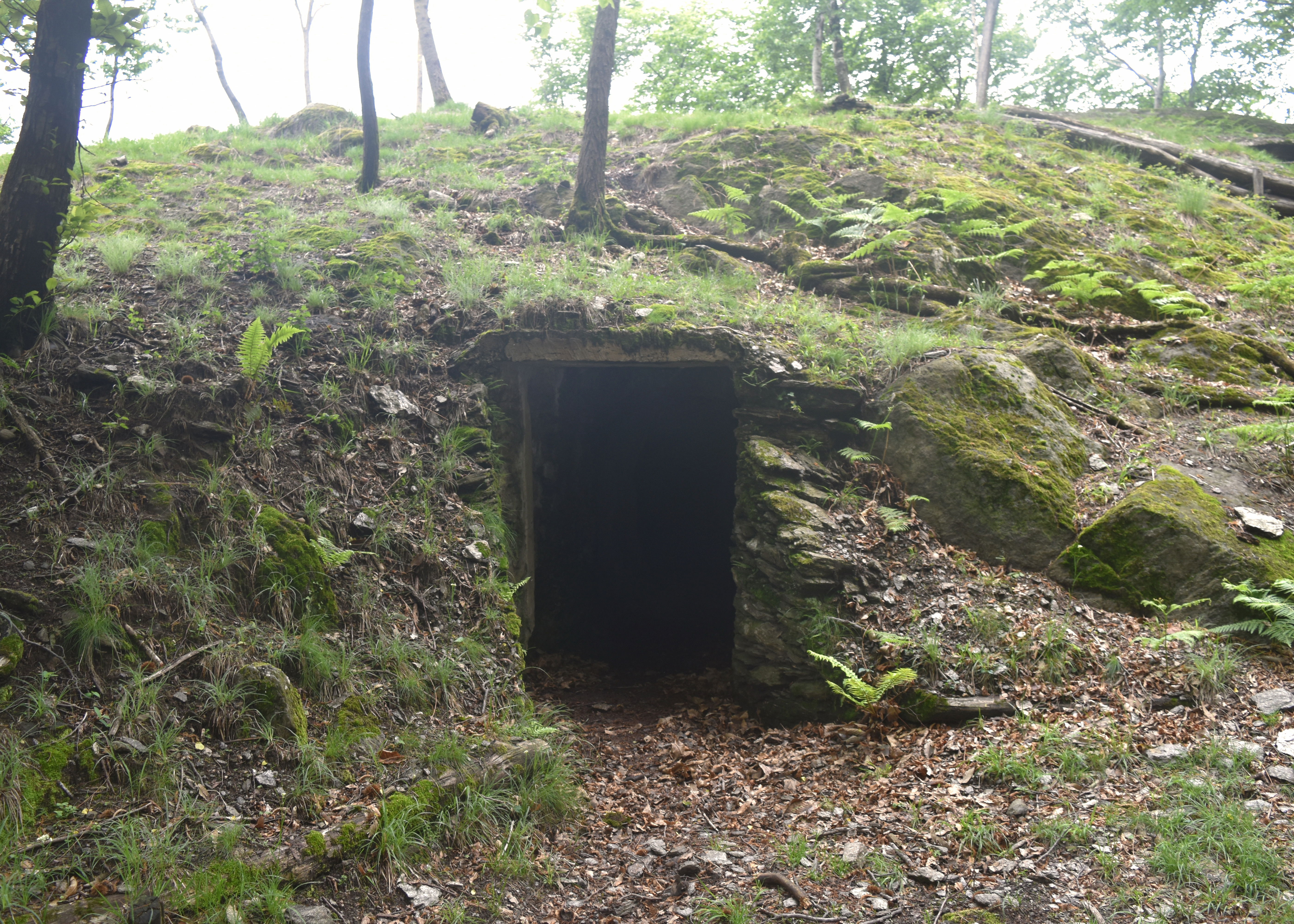
Underground bunker complex
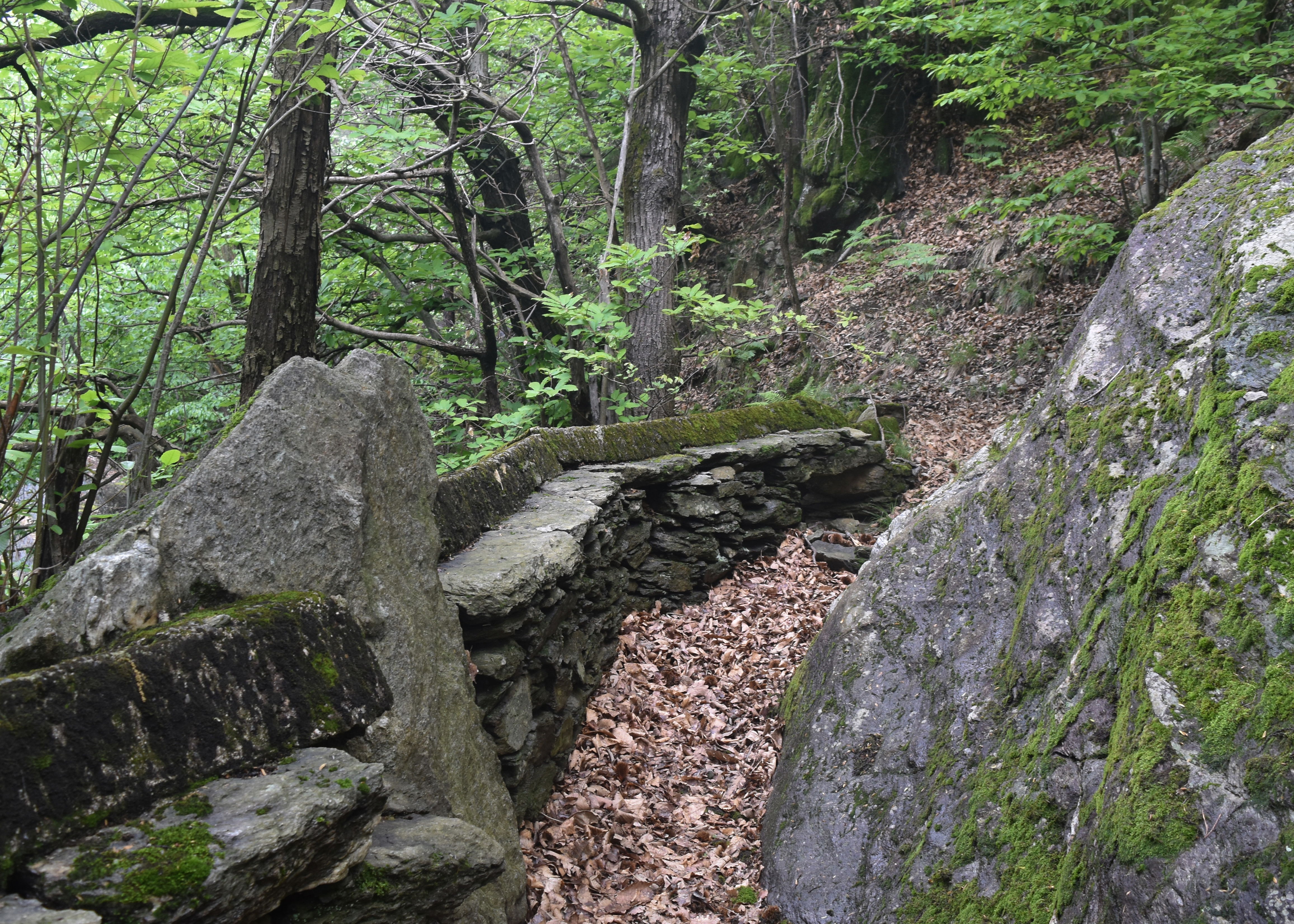
Trench lines
Further up there are bunkers dug into the mountain and with only the door visible and camouflaged among the vegetation. These provided shelter for the troops and must have been totally miserable, lacking much ink the way of ventilation or sanitary facilities. Not having a powerful torch, I did not venture far in, but presumably with oil light and no air, life was fairly unpleasant in the shelters.
In the last part of the site, the question of how they got the equipment and ammunition up there is answered. There is terrace where once there was the cable car that was supposed to provide food and ammunition to the soldiers, as well as other machine gun emplacements. The cable car is no longer there, but it must have been an effective away of getting supplies up there from a relatively safe position on the lake, The alternative was mules using the precipitous path up.
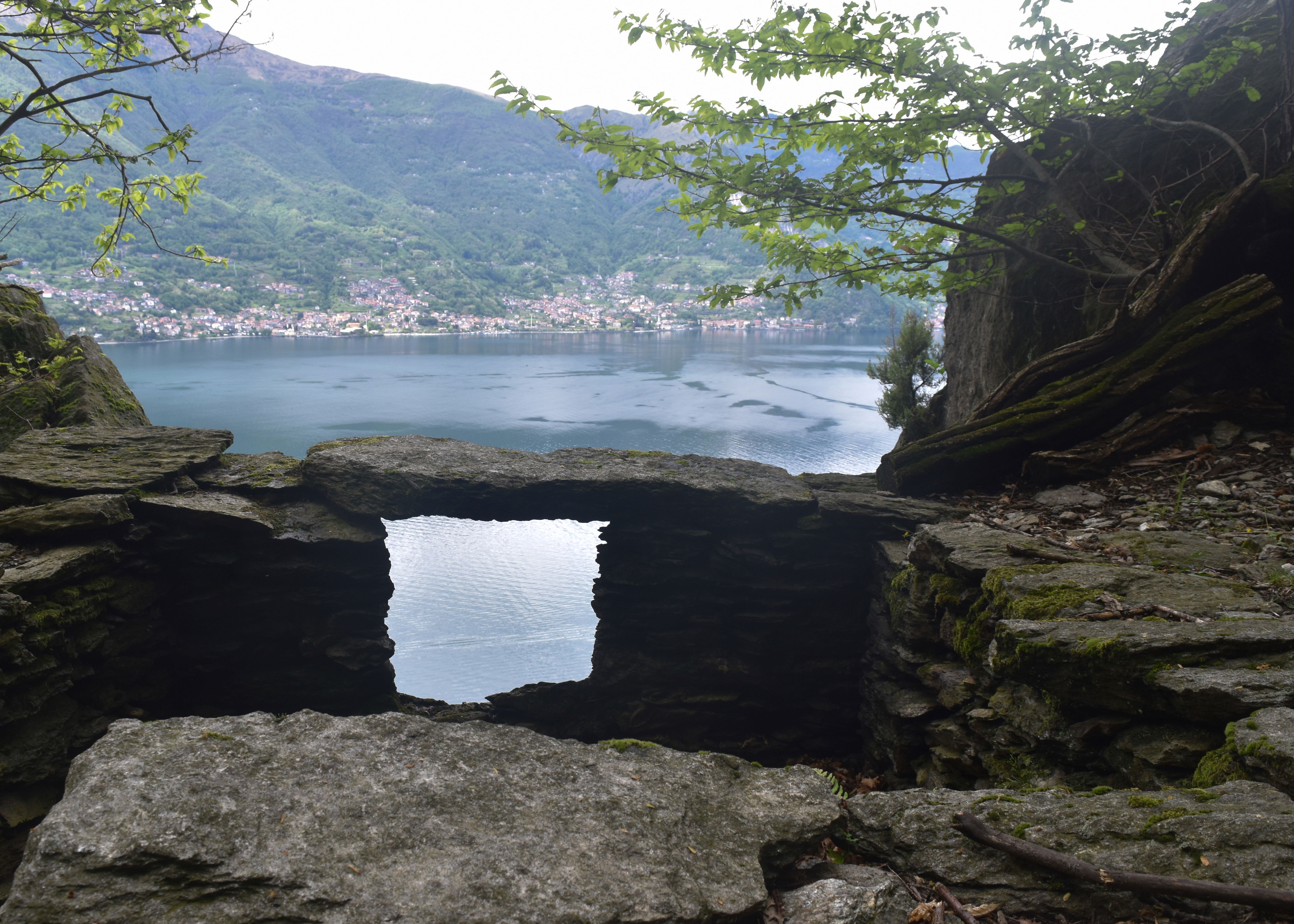
Another firing position
Getting down is easier although quite a lot of care is still required, it is slippery and steep. Nearing Corenno, one is rewarded by a great view if the castle from above, Emerging in Corenno, I am dying for a beer and something to eat. Although the only restaurant has stopped serving lunch, they do have some food on offer at 3pm. There is a fine local dish called Taroz , which is a typical Valtellina dish made with potatoes, green beans and a lot of cheese and butter , extremely rich and filling . Taroz , literally means mixed in local dialect, so the potatoes and beans are mixed together and copious local cheese added, it is a typical of Italian Cucina povera made well with simple local ingredients, although presumably not that old since it has potatoes in it . ( well post the Columbian exchange anyway). Taroz must have been quite a welcome dish to the soldiers up in the cold and damp of the fortifications.

A bowl of Taroz
To return from Corenno you can retrace your steps to Dorio , or continue in the other direction to Dervio, which is about half an hour along a quiet road which still forms part of the Sentiero del Viandante and is very easy going with nice views. Dervio is a an attractive lakeside village, although it is difficult to find the entrance to the railway station, which is not well sign posted. The Linea Cadorna, cost a lot of money and never saw a shot fired in anger, but the ruins do make an interesting trip.
And if life on the Cadorna life seems fairly familiar ,perhaps it is. One of the finest Italian novels has a similar theme . In l deserto dei Tartari (the Tartar Steppe) , Drogo is posted to a remote outpost overlooking a desolate Tartar desert; he spends his career waiting for the barbarian horde rumoured to live beyond the desert. Without noticing, Drogo finds that in his watch over the fort he has let years and decades pass and that, while his old friends in the city have had children, married, and lived full lives, he has come away with nothing except solidarity with his fellow soldiers in their long, patient vigil. Although set in a desert rather than up a forested hill, the theme is similar. The Italians sat up on the Cadorna Line , waiting for an enemy who never came and who portably was never going to come that way anyway When the Germans finally did occupy Italy, they came over the Brenner Pass and not through Switzerland. The novel is 29th in Le Monde’s 100 books of the 20th Century and is well worth a read. Maybe something to read on the fairly long train journey there and back.
The 10,32 train from Milan got me to Dorio at around 12,10. Getting up to the Cadorna Line and having a look around , takes least two and half hours. You can check the timetables at IT - Trenitalia